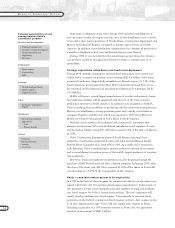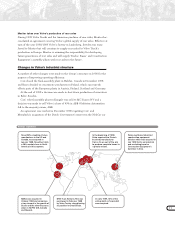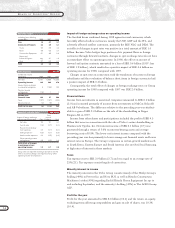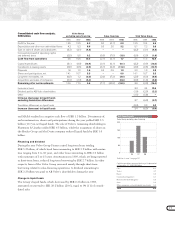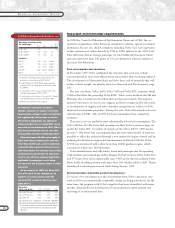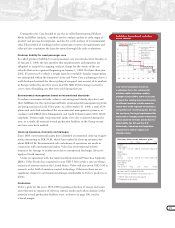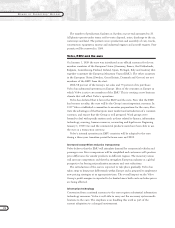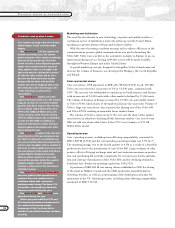Volvo 1998 Annual Report Download - page 22
Download and view the complete annual report
Please find page 22 of the 1998 Volvo annual report below. You can navigate through the pages in the report by either clicking on the pages listed below, or by using the keyword search tool below to find specific information within the annual report.
20
Important environmental requirements
In 1998 the Council of Ministers of the European Union and ACEA, the co-
operative organization of the European automotive industry, agreed on exhaust
limitations for new cars. ACEA members, including Volvo Cars, have agreed to
reduce emissions of carbon dioxide by 25% by 2008, relative to the 1995 level.
This will mean that an average passenger car sold within the European Union
may not emit more than 140 grams of CO2per kilometer, which is equal to 6
liters per 100 kilometers.
Fuel consumption and emissions
In December 1997 Volvo established the objective that each new vehicle
concept should be more fuel-efficient than the product that was being replaced.
The development of alternative fuels and drive lines, and of materials that will
reduce vehicle weight, are priority areas (see Research and Development, page
18).
The new city buses, Volvo 5000, Volvo 7000 and Volvo B7L, consume about
10% less fuel than the preceding Volvo B10L. Volvo’s new trucks in the FM and
FH series also consume less fuel than their predecessor models. The improve-
ments for the buses are due to new engines and lower weight and for the trucks
to development of engines and other driveline components as well as 10-20%
improved aerodynamic properties. During the year, Volvo also introduced a new
wheel loader, L220D, with 10-15% less fuel consumption than competing
machines.
This year’s new car models feature substantially lower fuel consumption. The
Volvo S80 has 12-19% lower fuel consumption than Volvo’s previous large car
model the Volvo S90. A number of variants of the Volvo S/V70, 1999 model,
provide 7-12% lower fuel consumption than the year earlier model. It has been
possible to effect the reduction through a new system for engine control and by
reducing the friction in engines and transmissions. In March 1998 the Volvo
S/V40 was introduced with a direct-injection (GDI) gasoline engine, which
consumes 6.9 liters per 100 kilometers.
Volvo manufactures and sells trucks, buses and passenger cars for operating
with methane gas (natural gas and/or biogas). Bi-Fuel versions of the Volvo S70
and V70 have been sold commercially since 1995 and in the bus industry Volvo
Buses holds a leading position with more than 100 vehicles sold in 1998. Trucks
introduced a natural gas-powered truck during January 1999.
Environmentally compatible product development
To ensure a low total impact on the environment from Volvo’s products, new
work tools for environmentally compatible design are being introduced. At the
same time, the program with Volvo’s suppliers has been intensified, with more
specific demands for the introduction of environmental control systems and
reporting of environmental data.
BOARD OF DIRECTORS’ REPORT
Legislative demands and emissions, cars
Emissions standards, g/km
US and Europe HC+
CO NOx HC NOx
EURO 96 12.2 – 0,5
EURO 2000 22.3 0.15 0.2 –
EURO 2005 21.0 0.08 0.1 –
California
TLEV 32.6 0.37 0.048 5–
LEV 32.6 0.19 0.056 5–
ULEV 31.3 0.19 0.034 5–
SULEV 40.62 0.012 0.0062 5–
ZEV 400 0–
1 EURO 96 - prevailing legal standard in EU, test
procedure in accordance with EC 96/44
2 EURO 2000 and EURO 2005 - proposed legal
standard in EU, test procedure in accordance with
EC 96/69
3 In accordance with emission standard LEV I (pre-
vailing), test procedure FTP75, 100K
4 In accordance with emission standard LEV II (model
year 2004-2007), test procedure FTP75, 120K
5 NMHC (Non-methane hydrocarbons)
Emissions,
Volvo cars, g/km CO HC+NOx CO2
Volvo S80 2.9 man. 10.16 0.06 232
Volvo S70 2.5 man. 0.42 0.15 236
Volvo S40 1.8i 0.16 0.33 164
Volvo S70 Bi-Fuel 0.22/0.84 0.16/0.24 198/264
1 In accordance with test procedure EC96/94. Values
for Volvo S70 Bi-Fuel pertain to propane/gasoline
operation
In contrast to emissions of carbon
dioxide, emissions of carbon monoxide,
hydrocarbons, nitrogen oxides and particles
are regulated by law in many countries.
The strictest regulations are applied in
California where the so-called ZEV law is
expected to be introduced in 2003. (ZEV =
Zero Emission Vehicle, that is, cars with
no hazardous emissions during operation).
Somewhat more flexible rules apply to
Volvo and other manufacturers who sell
fewer than 35,000 cars a year in California,
compared with companies that sell more
than that number. For example, the smaller
manufacturers do not have to offer pure
electric cars. Stricter emission legislation
applicable to passenger cars is being
introduced in the European Union in 2000
and 2005.
As of model year 1999, the Volvo S80,
S70, V70 and C70 are available on all
markets in versions which meet the
stringent LEV emission standards (see
table above).


